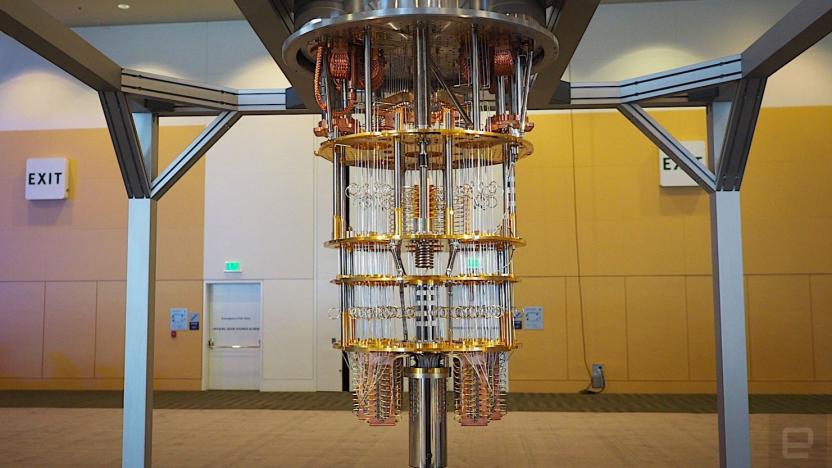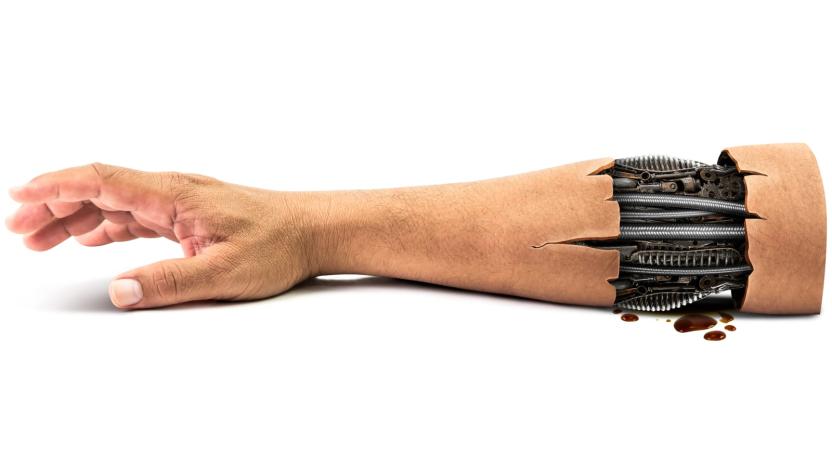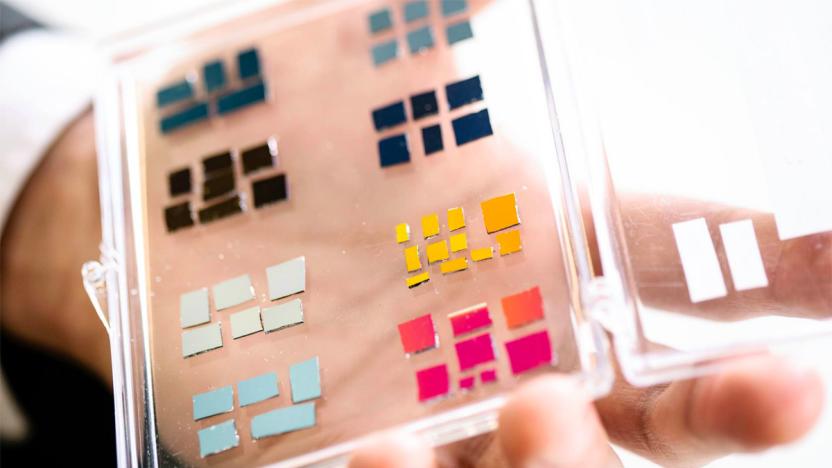oxforduniversity
Latest

'Animal Crossing: New Horizons' may actually be good for you
An Oxford study tapped into data from Nintendo and EA.

Oxford University halts donations and grants from Huawei
Huawei has faced increasing resistance from the US government and other countries, and now Oxford University has joined the growing number of groups distancing themselves from the company. The university, for now, will no longer accept research grants or donations from Huawei, The Guardian reports, with the ban stemming from "public concerns raised in recent months surrounding UK partnerships with Huawei."

Not even IBM is sure where its quantum computer experiments will lead
Despite the hype and hoopla surrounding the burgeoning field of quantum computing, the technology is still in its infancy. Just a few years ago, researchers were making headlines with rudimentary machines that housed less than a dozen qubits -- the quantum version of a classical computer's binary bit. At IBM's inaugural Index Developer Conference held in San Francisco this week, the company showed off its latest prototype: a quantum computing rig housing 50 qubits, one of the most advanced machines currently in existence.

Robots could wear flesh to help form transplants
Right now, you have to grow human transplants in a stationary environment. That's more than a little dangerous when they could buckle under the stresses of a real body. Oxford University may have a clever (if slightly ghastly) solution to that problem: have robots wear the tissue first. If you grow muscles on humanoid robots, the movement and overall shape of those machines would lead to grafts and transplants that are ready for serious strain.

Oxford University will offer free online courses in 2017
The highest ranked university in the world will soon join prestigious institutions like Berkeley, Harvard and MIT in offering free massive open online courses (MOOCs). Starting in February 2017, Oxford University will partner with nonprofit online learning platform edX to teach a freely available economics class titled, "From Poverty to Prosperity: Understanding Economic Development."

ICYMI: Science Spiderman would love and more
#fivemin-widget-blogsmith-image-344199{display:none;} .cke_show_borders #fivemin-widget-blogsmith-image-344199, #postcontentcontainer #fivemin-widget-blogsmith-image-344199{width:570px;display:block;} try{document.getElementById("fivemin-widget-blogsmith-image-344199").style.display="none";}catch(e){}Today on In Case You Missed It: A team of researchers from Boston University have figured out how to 3D print metals in a free-form style while Oxford University discovered that spider silk strands can recoil themselves when compressed to create stretchable circuit boards. A company called Otto is working on kits to retrofit 16-wheelers into self-driving autonomous rigs. And a menstrual startup wants women to attach a clip at the waist with extra long-stringed tampons clipped into the device. As always, please share any great tech or science videos you find by using the #ICYMI hashtag on Twitter for @mskerryd.

ICYMI: Barely hoverbiking, new hair dryer tech and more
#fivemin-widget-blogsmith-image-698312{display:none;} .cke_show_borders #fivemin-widget-blogsmith-image-698312, #postcontentcontainer #fivemin-widget-blogsmith-image-698312{width:570px;display:block;} try{document.getElementById("fivemin-widget-blogsmith-image-698312").style.display="none";}catch(e){}Today on In Case You Missed It: YouTuber Colin Furze teamed up with Ford to build a working hoverbike within just a few weeks, from his shed. It runs off of two diesel engines so granted, it's probably not the most mass-production friendly item, but does beg the question: What's holding everyone back, then?

Robots expected to run half of Japan by 2035
Data analysts Nomura Research Institute (NRI), led by researcher Yumi Wakao, figure that within the next 20 years, nearly half of all jobs in Japan could be accomplished by robots. Working with Professor Michael Osborne from Oxford University, who had previously investigated the same matter in both the US and UK, the NRI team examined more than 600 jobs and found that "up to 49 percent of jobs could be replaced by computer systems," according to Wakao.

Your future smartphone's screen will hardly need any power
As you're likely all too aware, smartphone screens chew up a lot of power -- that's why turning down your brightness frequently does more to save energy than closing an app. If Bodle Technologies has its way, though, your display will be a virtual non-issue. It's developing a phase change material that uses virtually no power, but is still sharp, vivid and visible in bright sunlight. While a lot about the technology remains a secret, it revolves around sending electrical pulses to flexible, transparent layers.

Oxford Dictionaries' Word of the Year is... an emoji
Oxford Dictionaries' Word of the Year is as much about capturing the cultural zeitgeist as it is reflecting the evolution of the English language, and that's truer than ever in 2015. For the first time ever, the institution chose emoji (the "tears of joy" icon you see above) to win the honor -- yes, actual words lost out. It's an odd decision, to put it mildly, but Oxford notes that the use of the word "emoji" more than tripled in the space of the past year, and the tears image was the most popular emoji worldwide.

Images created with nano-pixels are smaller than the width of a human hair
A group of Oxford University scientists have accidentally created a new display technology -- one that could enable a new era of smart glasses, bendable displays and even artificial retinas. The team refers to its discovery as 'nano-pixels;' it's a tiny sandwich of phase change material and transparent electrodes that change color when given a tiny jolt of current. These stacks can be used to draw tiny images, like the examples above, each one smaller than the width of a human hair. "We didn't set out to invent a new kind of display," explained research lead Harish Bhaskaran, his team was just exploring the relationship between the electrical and optical properties of phase change materials. Creating nano-pixels just sort of happened along the way.

New blood test is an early warning system for Alzheimer's disease
Of all the tragic things that come with Alzheimer's disease, its tendency to sneak up on people is one of the toughest to deal with. That's because by the time the condition is even detectable, there's a good chance it's already too late to turn back the tide. Earlier diagnoses could mean the difference between years of mental decline and a life of relative normalcy -- that's why a test developed by researchers at King's College London and Oxford University could be such a game changer. According to The Telegraph, the scientists can predict whether or not Alzheimer's will strike someone with existing memory loss problems by looking for 10 telltale proteins in their blood.

Scientists use lasers to imitate an exploding star here on Earth
It could be centuries (if ever) before humans can observe the behavior of a supernova first-hand, but scientists at the University of Oxford may have delivered the next best thing. They've recently simulated an exploding star by zapping an extremely thin carbon rod with a powerful laser; the resulting extra-hot blast (1.8 million degrees Fahrenheit) ripped through a chamber much like the real thing, as you can see pictured here. To add an extra dose of realism, the team added a plastic grid that replicated interference from dust and gases.

Doctors want to fix you with 3D-printed tissues made from water droplets
Doctors dream of using 3D-printed tissues to patch up injuries, but current techniques tend to kill a lot of the cells used in the process. Thankfully, researchers at Oxford University spin-off OxSyBio have found a gentler way to build these materials. Their technique 3D prints water droplets filled with chemicals that let them change shape and transmit electrical signals like real cells. The result is both kinder to living tissues and more controllable -- you don't have to worry about growth or other organic reactions.

World record setting experiment brings quantum computing a step closer to reality
Despite recent successes in the field, creating a quantum computer is really hard. For one thing quantum bits in a super positioned state (or qubits, the basic unit of data for quantum computing) have a hard time surviving at room temperature. Typically, these superposition states last for only a few seconds, but in a recent experiment at Simon Fraser University in Burnaby , researchers were able to keep a quantum system alive for a full 39 minutes. "These lifetimes are at least ten times longer than those measured in previous experiments," explained Stephanie Simmons from the University of Oxford's Department of Materials. "Having such robust, as well as long-lived, qubits could prove very helpful for anyone trying to build a quantum computer." Even so, they aren't particularly active ones - all of the qubits in the experiment shared the same quantum state. To perform actual calculations (and thus build a functioning quantum computer), a system would need to put multiple qubtis in different quantum states. Sound complicated? It sure is, but it's a significant step forward to building the ultrafast computing platforms of tomorrow. Eager to learn more? Check out the official press release at the source link below. [Image Credit: Stephanie Simmons, University of Oxford]

UK to test driverless cars on public roads before the end of 2013
While Americans have seen a few driverless cars on the open road, their British counterparts have had to settle for demos on private circuits. They'll get a better glimpse soon, though, as the UK Department for Transport now expects tests on public streets by the end of 2013. The initial trial runs will be gentle -- Oxford University's Nissan Leaf-based RobotCars will drive only on lightly trafficked roads, with humans tagging along in the event of a crisis. We haven't yet seen a timetable for more aggressive experiments, but we're not exactly in a hurry to compete with early autonomous cars during rush hour. [Image credit: Oxford University]

Oxford University researchers create new 3D printed 'soft material' that could replace human tissue
Water and fat -- those are the two primary building blocks Oxford University researchers have used to 3D print the droplet you see above. Sounds unremarkable until you consider its intended application as a human tissue replacement. By stringing together thousands of these so-called droplets (which measure about 50 microns across) using a custom-built 3D printer, the Oxford team believes it has engineered a "new type of material" that could eventually be used to ferry drugs throughout our internal systems to a specific target site, fill-in for damaged tissues or even mimic neural pathways via specially printed protein pores. The potential applications for medical science are impressive enough, but consider this additional benefit: since the droplets contain no genetic material, scientists can completely sidestep all the ethical red tape surrounding the alternative stem cell approach to artificial tissue. At present, the team's been able to string about 35,000 of the droplets together, but there's no real cap as to how large or even what type of networks can be made. If the money and equipment are willing, this Oxford team can make scifi dreams come true.

iPad navigates self-driving car
Researchers at Oxford University are working on technology that would let you ride in a self-driving car that's partially controlled by an iPad. According to a report in Clean Technica, the RobotCar UK project is headed up by Professor Paul Newman of Oxford University's Department of Engineering Science. The computer-controlled system uses sensors on the outside of a Nissan Leaf to generate a detailed picture of the car's surroundings. An iPad sits in the dashboard and is the control panel that lets the user interact with the system. With just a few taps, the driver can turn auto-drive on and off. The research team is still in the early stages of testing the self-driving system. It'll take some time for the technology to improve and for the cost to drop from its prototype price of £5,000 down to a consumer-friendly £100. You can check out a video of the car in action below and let us know what you think in the comments. Would you ride in iPad-controlled self-driving car? [Via AppleInsider and Clean Technica]

Researchers testing frugal autonomous car system, aim for $150 price tag (video)
Google certainly has pockets deep enough to trick out self-driving cars with any kind of pricey gear, but researchers at the University of Oxford have begun testing a solution that aims to keep things affordable. Currently, the system leverages an array of low-profile stereo cameras and lasers that rings up at about £5,000 (approximately $7,750), but the next goal is to knock the price down to £500, and eventually to a cool £100 (roughly $150). "Really, we do need to solve the engineering challenges of not relying on expensive sensors, but relying on cheap sensors," Professor Paul Newman told the Telegraph. "But doing some really smart things with those cheap sensor feeds." Rather than a vehicle that acts as a chauffeur at all times, Newman's vision for the modified Nissan Leaf, dubbed RobotCar, is for it to take control on select occasions. While drivers go about their commute, the system composes a 3D map of the car's environs and commits it to memory. When the auto identifies a familiar setting and feels confident about its ability to take the reigns, it could let the driver know it's ready to assume control. Right now, the automobile's been tested on private roads, but the team behind it is working with the UK's Department of Transportation to roll it onto public streets. Head past the jump for a glimpse of RobotCar in action.

Oxford makes big push into Bigfoot research, enlists Swiss zoologists for DNA study
The search for Bigfoot continues and, no, that's not a nod to a very special episode of Unsolved Mysteries. Though Harry and the Hendersons did its best to humanize that monster of myth, a group of well-heeled European scientists are seeking to go beyond the Hollyweird fantasy to actually prove the creature's existence using advanced genetic techniques on Yeti remains. Part of a collaborative effort between Oxford University and the Lausanne Museum of Zoology, the Collateral Hominid project aims to gather material from public and private cryptozoological collections for analysis to determine whether that elusive species branched off from bears or our neanderthal forebears. Project head Prof. Bryan Sykes hopes the research, the results of which will eventually make the rounds of peer-reviewed journals, will dispel skepticism that has surrounded this controversial creature by providing " a mechanism for... identification that is unbiased, unambiguous and impervious to falsification." Basically, these real-life Mulder & Scullys want incontrovertible DNA proof that these fantastic ape-like beings are simply the stuff of evolution. Whatever the case, the truth is most certainly out there, folks -- it's just likely encased in fossilized dung. [Image courtesy Worch.com]









